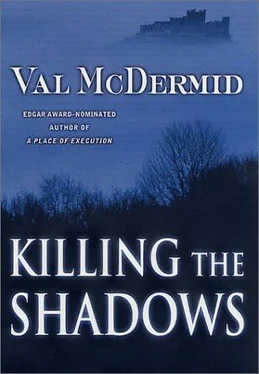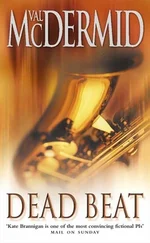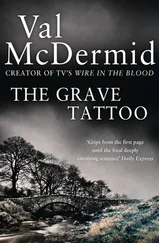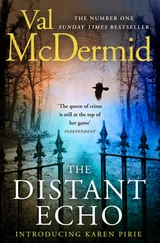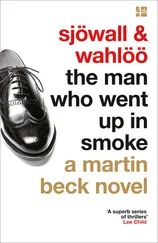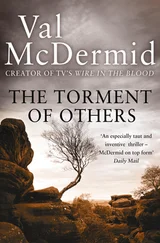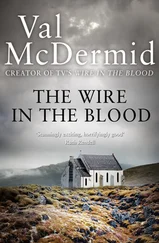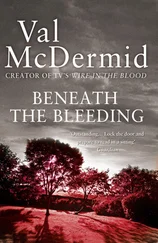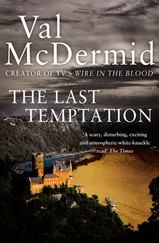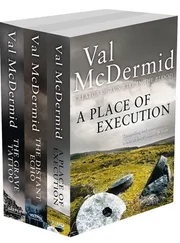After Lesley, she had found herself walking the streets of the city where it had happened, angry and frustrated that people could carry on as if nothing had changed, as if it was nothing to do with them. Of course, in a narrow sense, it was no direct concern of theirs. But Fiona had believed then as she believed now that societies got the criminals they deserved. Brutal crimes didn’t spring from nowhere; their seeds lay in the wider crimes of the community they impinged on. It wasn’t a popular view among law enforcement, and when she was working with the police, Fiona kept her views to herself.
So she looked around without comment. There wasn’t much to say other than the obvious. And Fiona had never liked stating the obvious.
Berrocal pointed to the bloodstained area, grinding his cigarette butt underfoot. “She was found lying towards the rear of the blood, not in it. It adds weight to the theory that he was behind her and she was standing up when he cut her throat. Mercifully quick, the pathologist says. Then, it looks as if he stepped back and let her fall.”
“The vaginal injuries were postmortem?” Fiona asked.
“Yes. He straddled her, we think. The grass is flattened on either side of her hips, as if someone had kneeled there. He cut her panties away, probably with the same blade. There were smudges of blood on the material. Then he broke the wine bottle on the ground and’—Berrocal cleared his throat ‘he inserted the broken bottle into her vagina. With considerable force. Several times. The glass fragments are on the right-hand side of the body, which supports the idea that he was right-handed.”
Fiona crossed to the side of the clearing and looked at the crime scene from the point of view the killer would have had. “The thing that strikes me most about this is what I mentioned earlier. The sexual mutilations are postmortem, which is unusual. There’s no sign of any kind of sexual activity before the attack. He went straight for the kill. No foreplay.”
Berrocal nodded. “You think this is significant?”
“It’s a marker of someone who feels very lacking in power. There’s nothing tentative about it either. It reveals a great deal of anger. So when I’m looking for linked crimes, I’ll be bearing in mind that they will probably exhibit similar markers.” Fiona hitched up her trousers, crouched down and studied the ground. There was no particular reason for her to do this. In truth, she learned very little from looking at crime scenes. She had never discovered anything that wasn’t covered by the files she would read later. But police officers expected her to absorb something from where the body had been found. It was almost a superstition, and so she’d long ago decided it was easier to humour them rather than start a partnership wrong-footed.
She stood up. “Thanks for letting me see this.”
“Does it tell you anything you didn’t know before?” Berrocal asked, stepping to one side and indicating she should precede him up the path.
The dreaded question. “It confirms one hypothesis,” she said. “Your killer knows his territory well. This isn’t the sort of place that a casual visitor would know about.”
“A local man, then?”
“I think that’s a safe assumption,” she said firmly. “He doesn’t just know about the existence of this place, he knows what happened here and what it means.” She heard the click of his lighter. Berrocal was clearly determined to get his blood-nicotine levels back to normal after an hour’s confinement in the car.
As they rounded the curve and the road came into sight, Fiona stopped abruptly. A miniature train with a string of grubby white carriages was grinding its noisy way across the viaduct. She could hear the tinny sound of a commentary, although it was too far away to make out any of the words. “What on earth is that?” she asked, pointing to the train and turning to Berrocal.
He raised his eyebrows in a world-weary expression. “They call it the Tren Real,” he sighed. “The Royal Train. It takes tourists on a ride through the old city and round the circunvalacion.”
Fiona grinned. “Hard to imagine the royal family riding on that.”
Berrocal’s face was pained. “It has no dignity,” he agreed. “It’s not my favourite example of Spanish tourism.”
They trudged back up to the car in silence. Fiona was oblivious to her surroundings, too busy with her thoughts for appreciation of landscape or the city vista that sprang out before them as they reached the level of the road.
“Now we’ll go to the church,” Berrocal announced.
Fiona concealed her impatience. She wanted to start work properly, not waste any more time looking at crime scenes. At this rate, she’d have been as well going back to the hotel with Kit. It would have been about as useful.
A couple of hundred feet above the panoramic route Fiona was travelling back to the city, Kit was opening a heavy pair of wooden shutters with ornate iron fittings. Light flooded into the room and he whistled softly at the view. The Parador Conde de Orgaz, named after the city’s most famous El Greco, sat on top of Emperor’s Hill with a breathtaking panorama of Toledo laid out before it. The almost unreal vision still bore a remarkable resemblance to the background of dozens of other El Grecos, in spite of the intervening four and a half centuries. The parador was perfectly sited on the bluff opposite the city, and their room commanded a view of the whole medieval city. Kit decided to fall prey to temptation.
Twenty minutes later, a taxi deposited him by the Plaza de Zocodover, a lively square which his tour guide claimed was the heart of social life in the city. Lined with cafes and cake shops, its tall shuttered buildings had an air of slightly decayed elegance. It appeared to be a typical provincial southern European city, Kit thought. Women sturdily crossing with their heavy bags of shopping, elderly men sitting smoking and chatting, teenagers in branded leisure wear lounging in doorways and on corners, furtively eyeing the opposite gender in between posing for their benefit. But it hadn’t always been like this.
Toledo, he knew from his reading, had been captured first by the Romans, then by the Visigoths, next by the Moors and finally by the Christians. Although it had become the capital of Castile and the base for the medieval military campaigns against the Moors, it had also established a reputation as a haven of cultural tolerance.
But all that had changed with the dynastic marriage of Fernando of Aragon and Isabella of Castile in 1479. Isabella’s personal confessor was Cardinal Tomas de Torquemada, the man appointed by the Pope as the first Grand Inquisitor of the Spanish Inquisition.
Kit had told Fiona only that he was interested in seeing the El Grecos in Toledo. But that was merely a fragment of the truth. What had drawn him to this city was the prospect of walking the very streets Torquemada had walked, many of them virtually unchanged since the fifteenth century and earlier. He wanted to let his imagination carry him back in time to an era when the streets of Toledo were tainted with fear and hatred, when brother denounced brother, when ordained priests invented torture methods so robust they were still in use, when the state perverted a religious crusade into a means to enrich itself.
Toledo was a city that, by conquest and oppression both, was soaked in the blood of its people. The tantalizing prospect of discovering how much of that atmosphere had persisted was what attracted Kit’s imagination.
It wasn’t hard to erase the modern images and see the streets as they must formerly have been. The buildings were the same, tall tenements with narrow twisting passages between them, their facades alternating between patched eroded brick and pale stucco that had generally seen better days. Studded with windows shuttered against the September heat, the only thing that broke up the frontages were lines of washing strung across the alleys.
Читать дальше
Конец ознакомительного отрывка
Купить книгу
